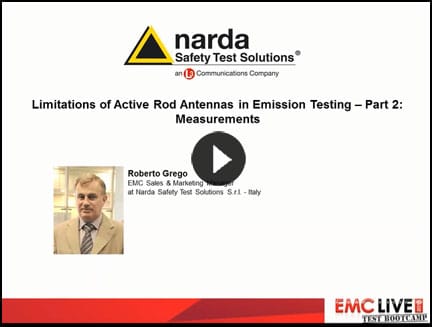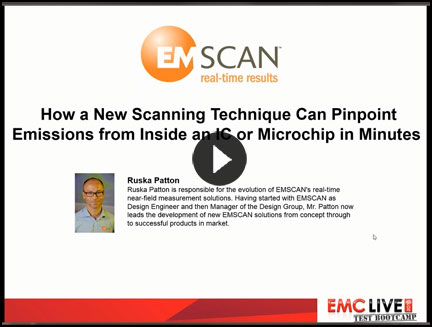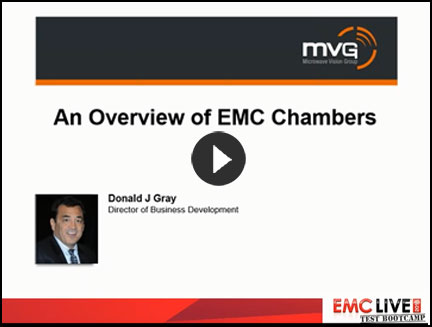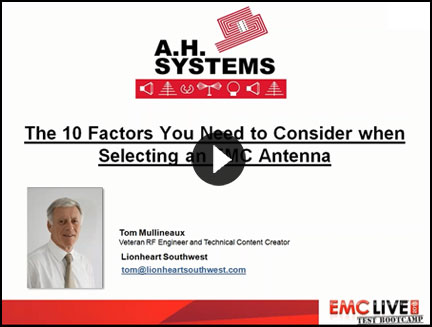 |
|
| Rohde & Schwarz Presents “Understanding the Evolution From Traditional Pass/Fail Testing to Enhanced EMI Characterization” | |
 |
|
| Speaker: Paul Denisowski
Overview: Detecting the max peak of emissions no longer meets the needs of most EMC engineers and does not help in understanding or locating the source of a potential interferer. And what’s worse: pulsed / intermittent and time varying emissions often remain undetected. Advances in EMI Receiver architecture and digital signal processing are revolutionizing the expectation of the EMC community. Time Domain Scan utilizing FFT technology not only greatly increases scan speed, but also improves the capability to detect pulsed / intermittent signals minimizing undetected time varying emissions. And Digital Signal Processing provides enhanced EMI diagnostic capability in the form of new graphical user interfaces such as Persistence Mode and Spectrograms. This presentation will cover the evolution of EMI Receiver capability concentrating on the numerous benefits of FFT technology and how the information is presented to greatly improve EMI Diagnostic capability. |
|
| Narda Presents “Limitations of Active Rod Antennas in Emission Testing – Part 2: Measurements” | |
 |
|
| Speaker: Roberto Grego
Overview: This webinar will discuss the results from a practical solution to the intrinsic limitations and drawbacks, such as impedance variations, of rod antennas as used for emissions testing. The solution consists in using a fiber optic instead of a coax cable, and by connecting the antenna rod directly to an embedded EMI receiver. By integrating the receiver with the antenna, the drawbacks of transferring the RF signal via fiber optic in analog mode are avoided. This webinar should be attended by all compliance and test engineers, especially those involved in military and automotive electronics, and any engineer involved in testing to CISPR 12, CISPR 16, CISPR 25, MIL-STD, and DO-160. |
|
| EMSCAN Presents “How a New Scanning Technique Can Pinpoint Emissions from Inside an IC or Microchip in Minutes” | |
 |
|
| Speaker: Ruska Patton M.Sc.
Overview: The very-near-field scanning method based on an array of probes provides real time visualization of the spatial distribution of emissions from PCBs but lack the ability to do very high resolution scanning. Single probe mechanically swept solutions can do very high resolution scanning but they are extremely slow. A new method that combines the array of sensors with mechanical motion combines the benefits of both techniques and provides the fastest high resolution scanning available. This presentation will show a working system that implements this combined technique and explain how the system is able to peer inside an IC and isolate the radiation from individual pins and wire bonds. Testing from real world PCBs with multiple sources of emission will be presented. |
|
| MVG Presents “An Overview of EMC Chambers” | |
 |
|
| Speaker: Donald J Gray
Overview: The webinar will give a general overview of anechoic chambers in general and will discuss the basics of EMC chambers. We will discuss the common test distances (e.g., 3 m chambers, 10 m chambers) and how this affects the overall performance. |
|
| A.H. Systems Presents “The 10 Factors You Need to Consider When Selecting an EMC Antenna” | |
 |
|
| Speaker: Tom Mullineaux
Overview: The antenna is one of the least understood components in an EMC test instrumentation set-up, and a poor choice of antenna(s) can lead to multiple problems including erroneous test data, failed tests, lengthy or difficult test procedures, and challenges with repeatability. Useful to beginners and the more experienced alike, this webinar, presented by AH Systems, guides you through the key parameters that need to be considered when selecting an EMC test antenna. Attendees will also receive a handy check list for practical future reference. |
|
| Previous Webinars: | |
| Cost-Effective Use of HDI (Microvia) PCB Technology for SI, PI and EMC | |
| Speaker: Keith Armstrong
Overview: Microvia (High Density Interconnect, HDI) PCB manufacturing technology has developed rapidly in recent years, and can now be used to reduce bare-board cost where a Through Hole Plate (THP) board would need 10 or more layers. And microvia’s benefits for good EMC (and SI and PI) design at board level mean it can reduce overall unit-cost-of-manufacture even where THP boards would require fewer than 10 layers. This webinar looks at what microvia board techniques are now available, and how they can be used to help achieve good EMC whilst reducing costs and getting to market more quickly.
|
|
| PCB Suppression of ICs with BGA or Multiple Power Rails | |
| Speaker: Keith Armstrong
Overview: Most EMC design textbooks that cover printed circuit board (PCB) design and layout – including mine – do not cover the special EMC issues associated with Ball Grid Array devices (BGAs), so this webinar covers PCB design techniques that will reduce their emissions and increase their immunity. In particular, how to get good plane meshes under them, and how to deal with their multiple power planes.
Click here to download a pdf of the presentation.
|
|
| Cost Effective Use of Close Field Probing Part II | |
| Speaker: Keith Armstrong
Overview: This webinar – number 2 in a series of 2 – describes simple, low-cost, cost-effective, qualitative EMC bench-testing techniques for emissions and immunity, using close-field probes (that many people make themselves) and low-cost portable measuring instruments.
Click here to download a pdf of the presentation.
|
|
| Troubleshooting Tools and Pre-Compliance Testing | |
| Speaker: Ken Wyatt
Overview: Failures during EMC product qualification testing can result in expensive delays and possible redesign. Understanding simple EMC design basics go a long way towards minimizing these risks. This webinar will review the most common design issues and demonstrate simple troubleshooting techniques to identify issues early in the design process.
Click here to download a pdf of the presentation. |
|
| Cost-Effective Use of Close-Field Probing Part I | |
| Overview: This webinar – number 1 in a series of 2 – describes simple, low-cost, cost-effective, qualitative EMC bench-testing techniques for emissions and immunity, using close-field probes (that many people make themselves) and low-cost portable measuring instruments.
Click here to download a pdf of the presentation.
|
|
| Understanding EMC Basics 3: Grounding, Immunity, Overviews of Emissions and Immunity, Crosstalk |
|
Overview: This webinar – number 3 in a series of 3 – describes a simple, easy non-mathematical engineering understanding of the physical underpinning of electromagnetics.This understanding leads directly to EMC design techniques that have been proven many times in real-life in many countries to easily:
– and so save time and money overall whilst reducing financial risks.
Click here to download a pdf of the presentation.
|
|
| Understanding EMC Basics 2: Waveforms, Spectra, Coupling, Overview of Emissions |
|
Overview: This webinar – number 2 in a series of 3 – describes a simple, easy non-mathematical engineering understanding of the physical underpinning of electromagnetics.This understanding leads directly to EMC design techniques that have been proven many times in real-life in many countries to easily:
– and so save time and money overall whilst reducing financial risks.
Click here to download a pdf of the presentation.
|
|
| Understanding EMC Basics: EM Field Theory & Three Types of EM Analysis |
|
| Overview: This webinar will help viewers understand EMC basics, specifically EM field theory; and it will also discuss three types of EM analysis. The webinar describes a simple, easy non-mathematical engineering understanding of the physical underpinning of electromagnetics leads directly to design techniques for EMC that save time and money overall, improve product functional performance, increase profitability and reduce financial risks.
Click here to download a pdf of the presentation. |
|
|
Cost-effective EMC Design by Working with the Laws of Physics |
|
| Overview: This introduction explores how a simple nonmathematical understanding of basic electromagnetic theory leads directly to EMC techniques that save time and money, improve product performance, and reduce financial risks.
Click here to download a pdf of the presentation. |







